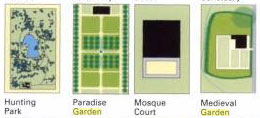Human Flower Project
Tuesday, May 29, 2007
Garden History—Bookish
The Bookish Gardener has returned! Chan Stroman is back at her lyrical and literary blog, and generously has delivered this fine review to us. Thank you, Chan. Your readers have missed you.
 Garden History:
Garden History:
Philosophy and Design
2000 BC – 2000 AD
by Tom Turner
Taylor & Francis Ltd
Spon Press, 2005
Reviewed by
Chan Stroman
The gardener peers into the locus of the open, recurved narcissus, eye to pheasant’s eye. Although brief moments like this sometimes imprint themselves in the gardener’s personal history, most quickly wash away with the rest of daily life’s ephemera. In this case, though, there’s other history bound up with this particular flower. It was originally grown in a garden that I’ve never seen, its bulb gathered, preserved and sent from the garden of a friend that I hope to meet one day really, not just virtually. I recall that history every spring as the poeticus blooms, although that history will ebb away some day too, as the gardener leaves the garden. The garden to me is intensely personal, in how it’s made, how it feels, what it expresses, and what it means. In the garden, my eye—and mind—zoom in.
Zoom out. — Garden History: Philosophy and Design 2000 BC – 2000 AD, by Tom Turner, takes you up, and away, and way back, across the history of the idea of the garden in Western civilization over the past four thousand (yes, thousand) years. As an object, it’s a beautiful book. You’ll appreciate its handsome production values, from the sculpturally gnarled, sepia-toned, snow-dusted grand oak on the cover, to the luscious heft of the paper that make leafing through the pages a tactile pleasure. Despite the ambitious sweep of its title, the book keeps to a judicious limit on pages (less than 300), and is amply illustrated with photographs of excellent composition, a few academic tables, and whimsical sketches here and there.
 Statues at Charlottenburg, Berlin
Statues at Charlottenburg, Berlin
Photo: Tom Turner
from Garden History
Gorgeous, yes, but Garden History is no mere coffee-table tome of all style and no substance. The reader is given the chance to become an armchair traveler through space and time, to see how humans and their cultures here in the Western world have sought to enclose, tame and remake their natural surroundings. This book isn’t meant to and doesn’t cover horticultural techniques or functional garden design. Instead, it’s an exploration of how the idea of the garden seems to have become an inevitable element of how every culture comes to express itself.
Reading Garden History is like taking a tour of a world-class museum, personally guided by an erudite and engaging curator. Of necessity, much historical data is rendered in shorthand, leading to often amusing examples of what might be called “world history as elevator speech”:
Italy was dominated by Spanish influence during the reign of the Hapsburgs (1525-1700), although some areas, including Venice, the Papal States, Tuscany and Genoa, retained nominal independence. It was a period of relative economic decline as the focus of world trade and industry shifted from the Mediterranean to the Atlantic. But it was also the period when Rome recovered its ancient role as the hub of western civilisation: the place which every artist and every tourist felt compelled to visit.
As we start with earliest history in the cradle of civilization, the author looks to archeology and ancient texts to reconstruct the history of what might have been the earliest forms of the garden. We’re led to ponder: was the first garden a place (Eden)?—Or an idea: a line marked in the sand, joined end to end to form a boundary, distinguishing what’s “within” from what’s “without.” As civilizations advance and evolve, we’re shown the evolution of the many species of the idea of the garden: as property, sanctuary, worship site, memorial, status symbol, plant “zoo,” public commons. Famed gardens such as the Villa d’Este, Taj Mahal, Versailles and Sissinghurst are put in fresh perspective, as we’re stimulated to think about them as more than just pretty landscapes.
 Garden designs through time (detail)
Garden designs through time (detail)
Drawings: Tom Turner
from Garden History
Despite the breadth of the subject matter, the book is more accessible than daunting. I think it’s best approached in the same way in which you might visit a museum. If you’ve got a particular interest in a certain historical era or civilization, the book’s index will point you to the chapters (museum exhibits) on which you’ll want to focus your attention …or you can browse through numerous chapters to get just a taste of it all (like a tourist given two hours off the bus to wander through the Tate)…or open a page at random (like an in-town visitor who can pop in regularly over the lunch hour). However you come to it, the book gives a great jumping-off point for delving further into cultures (and their gardens) that pique your interest.
(Although Garden History only covers gardens of the West, broadly defined to include West Asian and Islamic gardens, I’d love to see the same treatment given to the Far Eastern gardens and history of China, Korea and Japan. Their diversity of flora, dynastic histories, and the prominence of gardens in their literature and culture would make a fascinating journey.)
This stimulating book leaves me pondering: How will the idea of the garden in our times and in American culture be remembered centuries hence? Will anyone look back on and remember our lawns, community gardens, urban high-rise “green” rooftops, and preserves? And if they do, what will these things say about the way we were?
Art & Media • Culture & Society • Gardening & Landscape • Permalink




